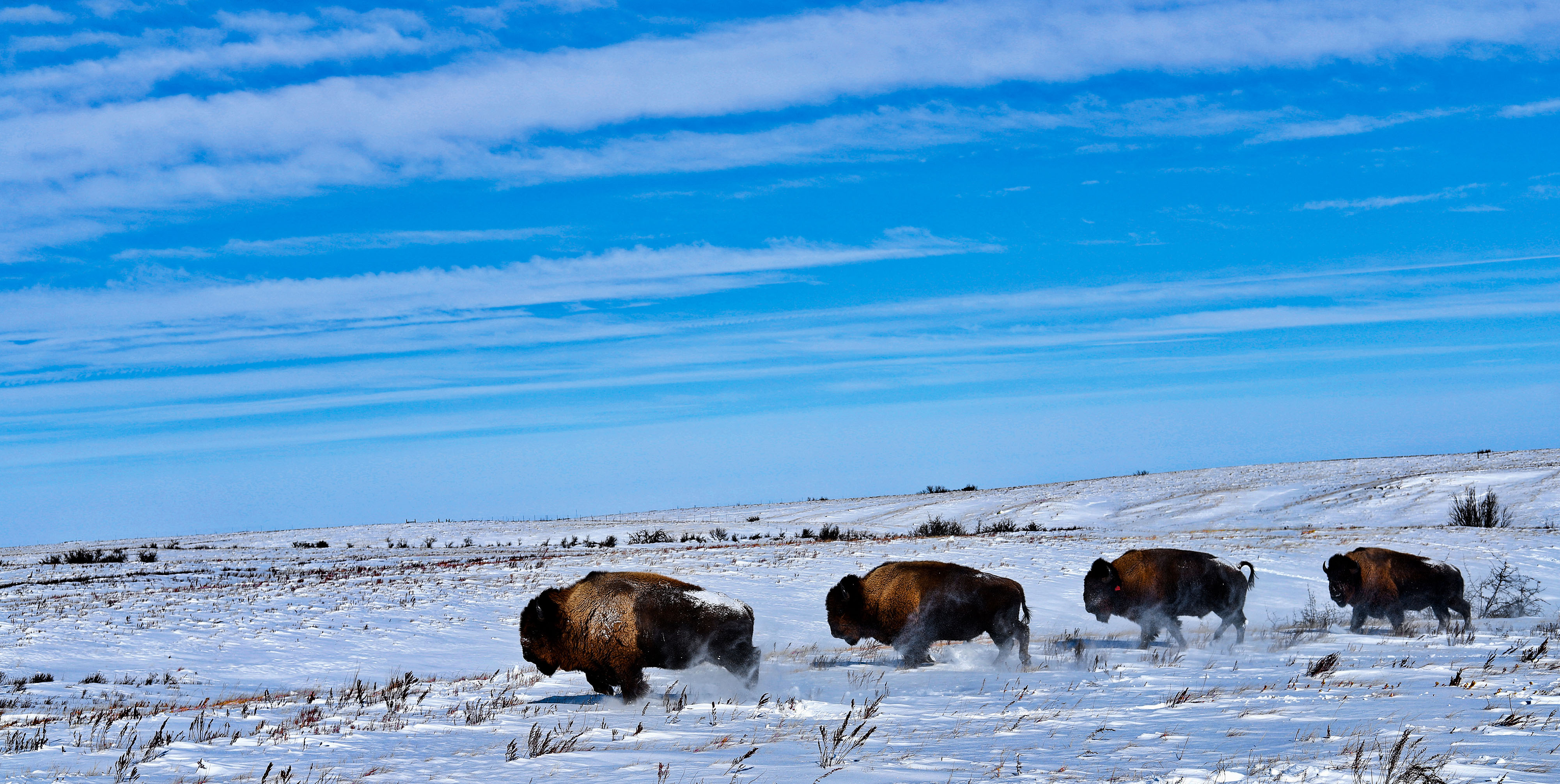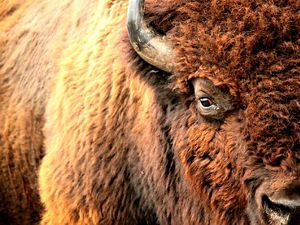Partnering with Indigenous Peoples and Local Communities
American Buffalo Return Home to Tribal Lands
Restoration is about more than land.
In 2020, The Nature Conservancy began work with the InterTribal Buffalo Council, the non-profit Tanka Fund and other Indigenous partners to transfer bison (also known as American buffalo) from TNC herds to Native Nations and communities. To date, 1,800 bison from 11 herds at TNC preserves, like Medano-Zapata Ranch in Colorado’s San Luis Valley, have made the long journey—over time and distance—back to their ancestral grazing lands.
The Nature Conservancy’s Medano-Zapata Ranch Preserve in the San Luis Valley of Colorado sprawls across 23,000 acres within sight of Great Sand Dunes National Park and Preserve. Today, Medano-Zapata is also home to 2,000 bison who drift across the grasslands in the shadow of the Great Sand Dunes like shadows themselves.
And every year since 2020, a selection of these animals (also known as American buffalo) has traveled with other bison from 11 herds across TNC’s network of preserves to homes on tribal lands throughout the Great Plains and beyond.
The selective transfer of bison is part of TNC’s partnerships with the InterTribal Buffalo Council (ITBC), the non-profit Tanka Fund and other Indigenous communities to restore bison to the Tribes.
Since 2020, TNC has, under the auspices of those partnerships, transferred 1,800 American buffalo to Indigenous lands and communities. Transferring buffalo at this scale supported a quadrupling of the number of animals made available through ITBC's Surplus Buffalo Program in 2022, marking the largest restoration of buffalo to Native Nations in history. 600 American buffalo have been transferred in 2024, sent home to other ancestral grazing lands.
Bison Homecoming







Bison Home-Sending Becomes Buffalo Homecoming
TNC currently owns and manages approximately 6,600 bison on 11 preserves in the United States, including the Tallgrass National Prairie Preserve, cooperatively managed by TNC and the National Park Service.
Did You Know?
The Nature Conservancy is the second largest private owner of bison in the United States, after Ted Turner.
Recognizing that most North American grasslands evolved under the influence of climate, fire and grazing, TNC first reintroduced bison to our preserves in 1978 and continues to support bison to ensure those lands remain diverse and resilient.
Bison are a keystone species for grasslands and returning them to the land was a restoration goal and a conservation tool. From a purely scientific perspective, their presence is integral to thousands of natural relationships. Their grazing behavior and the effects they have on the prairie naturally promotes biodiversity and helps a wide range of wildflowers, plants, insects, and amphibians flourish.
On TNC preserves, a bison’s primary job, so to speak, is to help maintain the health of grasslands.
For the Indigenous Peoples TNC partners with bison are much more. We send them to the Tribes as bison and they are welcomed home as buffalo—a cultural keystone—as much as an ecological one, and core to tribal identity.
Quote: Jason Baldes
The restoration of buffalo back to our communities opens a new chapter for cultural revitalization and ecological restoration.
Rematriating Buffalo
Rematriation—the Indigenous concept of restoring balance to the world—best captures the benefits of returning buffalo to their original lands.
“The restoration of buffalo back to our communities opens a new chapter for cultural revitalization and ecological restoration. Collaboration in Tribal buffalo restoration means we can work together for the betterment of buffalo and our Tribal homelands,” says Jason Baldes, who is Vice President of ITBC Board of Directors and is Tribal Buffalo Program Manager for the National Wildlife Federation.
Today, the lands of Indigenous Peoples across the U.S. and Canada contain more intact ecosystems than all national parks and nature preserves combined. Indigenous Peoples within the United States manage approximately 20,000 buffalo on over 1 million acres (many, but not all, of these animals began life on TNC preserves).
Returning buffalo to Tribal lands is not new. ITBC has been working with Tribes for more than 30 years to restore buffalo to Tribal lands to preserve their historical, cultural, traditional, and spiritual relationship for future generations. Currently ITBC consists of 83 tribes in 22 states and continues to add new Tribes in support of this effort. Tanka Fund currently works with 19 different projects in 5 states and is the sister organization to Native American Natural Foods that developed the Tanka Bar brand.
Reconnecting Long-Severed Ties
Since time out of living memory, buffalo and Indigenous Peoples have had a critical relationship across North America as stewards of the lands and waters on which a diversity of life depends. By the late 1800s, this relationship was severely disrupted: buffalo were slaughtered to near extinction and Indigenous Peoples had been largely forced into life on reservations, separated from the once great herds that were hunted to the thinnest edge of survival.
The people suffered from the separation, as did the lands and waters. The restoration of American buffalo to their traditional grazing lands under the auspices of their traditional stewards is part of knitting up long-severed connections—environmental, cultural and economic.
The Far-Reaching Benefits of Returning Bison to Tribal Lands
TNC’s partnerships with Tanka Fund, ITBC and other partners also help relieve grazing pressure on public and private lands while benefitting Native communities, families and Tribes who want to start new, Tribally, family-, or community-managed herds, or who want to grow and supplement existing herds through continuing restoration efforts.
Tribes and Native communities create the infrastructure needed to restore buffalo geographically across the country, preserving unique genetics and thousands of years of knowledge about maintaining the relationship between buffalo and their Native relatives.
“The partnership with TNC has been a blessing for the Tribal Nations which we serve. We’re extremely excited about the opportunity to grow this relationship in the coming years,” Troy Heinert, ITBC Executive Director.

Stay in the Loop
Sign up to Receive Updates about TNC's Conservation Work around the World




